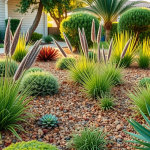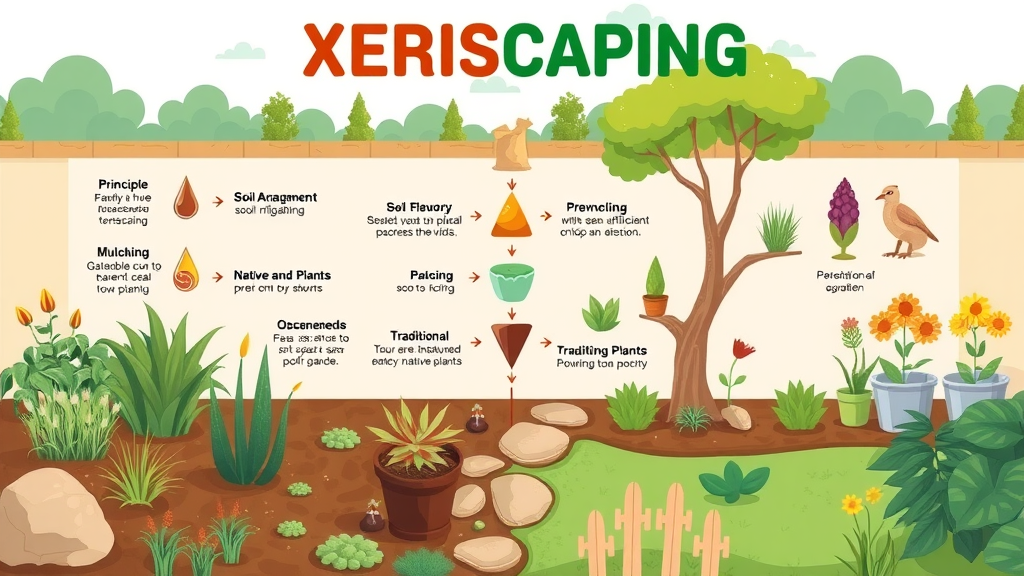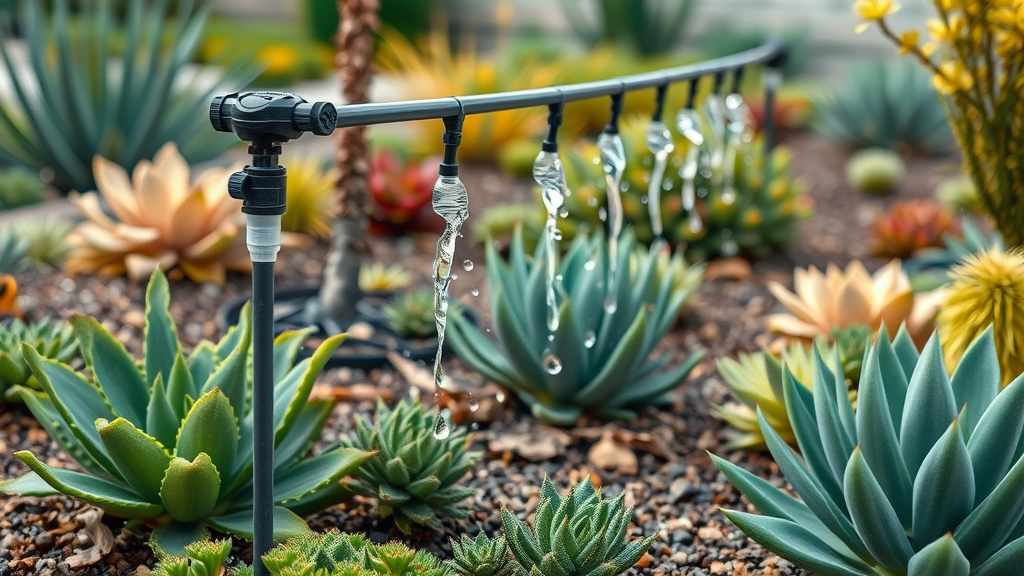
Discover Drought-Tolerant Plants San Diego Loves for Easy Care
October 7, 2025
Water-Efficient Landscaping That Will Cut Your Bills Fast
October 21, 2025Did you know that switching to xeriscaping can reduce outdoor water usage by over 50%? For San Diego homeowners, this statistic does more than turn heads—it signals the substantial savings, environmental stewardship, and year-round beauty possible with expert xeriscaping tips. Learn how this transformative landscaping approach can redefine your yard or garden, even in the face of our region’s persistent drought and sky-high water bills.
Startling Statistics: Why Xeriscaping Tips Matter in Today’s Water-Conscious World
In a region like San Diego—where dry weather can persist for months and water supply is under constant pressure—landscape choices are about more than just curb appeal. Outdoor irrigation accounts for up to half of a typical home’s total water usage. That means your front yard isn’t just the first thing guests see; it can also be your single biggest source of water waste. With ongoing droughts, population growth, and environmental concerns, finding practical ways to reduce water without sacrificing beauty is no longer a good idea but a necessity.
Homeowners are feeling the squeeze in their water bills as rates continue to climb, especially after dry winters and restricted water supply years. Fortunately, xeriscaping tips offer a pathway to sustainable, stunning landscapes that thrive even when water is scarce. By incorporating drought tolerant and native plants, grouping plant species with similar water needs, and installing efficient irrigation systems, you can create a beautiful yard that protects your wallet and the environment at the same time. Recent surveys show that homes with drought-wise gardens report water conservation savings upwards of 40–60%, and San Diego Water Authority estimates more than 40 million gallons could be saved across the city per year if residential properties transition to water-wise landscaping.

“Switching to xeriscaping can reduce outdoor water usage by over 50%—profound savings for San Diego homeowners.”
Understanding the Urgency: Drought and Water Bill Pressures in San Diego
San Diego homeowners are no strangers to rising water bills and continuous drought. Recent years have brought shorter rainy seasons and extended dry weather, putting added stress on the region’s water supply. These challenges make it vital to adopt landscape solutions that work with nature, not against it. Xeriscaping tips help residents prepare for late or minimal winter rain, slashing unnecessary water waste while supporting resilient, green outdoor spaces.
Drought conditions mean traditional lawns not only require excessive water but are often the first to suffer during restrictions. By incorporating drought tolerant plants and ground covers, you can ensure your garden remains vibrant and healthy throughout the season. Furthermore, the City of San Diego offers various rebate programs and incentives to encourage homeowners to make water-wise upgrades, a definite ‘good news’ scenario for those concerned about the bottom line. Thoughtful xeriscape design empowers you to enjoy a thriving garden and a healthier water bill, even as water rates rise.
What You’ll Learn: Mastering Xeriscaping Tips for Sustainable Beauty
- How to select the most tolerant plants and native plants for xeriscaping
- Water-saving design strategies tailored for dry San Diego winters
- Essential xeriscaping tips for beginners and experienced gardeners alike
Xeriscaping Tips Foundations: What Is Xeriscaping and Why Adopt It?
Definition and Principles of Xeriscaping
The word “xeriscape” springs from the Greek word “xeros,” meaning dry, and “scape,” referring to landscape. But don’t let the name fool you: xeriscaping tips are about more than just dry, gravel-dotted gardens. At its core, xeriscaping is a landscaping philosophy that minimizes water use while maximizing beauty and practicality. Seven core principles guide every good xeriscape design: choosing drought tolerant and native plants, soil improvement, efficient irrigation, practical turf areas, mulching for water retention, proper maintenance, and wise plant placement.
This approach encourages selecting plant species that require less water and thrive in the local climate—such as succulents, sages, and ground covers native to Southern California. It also recommends grouping plantings by similar water needs and using organic matter to improve soil structure, increasing both water retention and plant health. The result is a yard or garden that offers year-round interest, works with nature, and delivers substantial water conservation.

Economic Benefits: Saving on Your Water Bill
Xeriscaping isn’t just about water conservation—it’s also about lowering your expenses. Many San Diego homeowners are surprised by how fast their investment in tolerant plants, efficient irrigation systems, and mulching pays off through reduced water bills. On average, a family that switches to xeriscape design in their front yard can reduce water costs by 40–60% per year. That means hundreds of dollars in annual savings, and those numbers only climb higher during drought years when water rates spike or usage quotas are imposed.
But the economic perks go beyond the water bill. Native plants and drought tolerant ground covers are often lower maintenance compared to traditional turf, further trimming costs associated with fertilizers, pest control, mowing, and other routine landscape tasks. By working smarter with xeriscaping tips, you’ll put less strain on the city’s water supply while enjoying a thriving garden that’s as friendly to your wallet as it is to your eyes.
Environmental Advantages of Using Tolerant Plants and Native Plants
Adopting xeriscaping tips brings powerful environmental benefits, particularly in water-stressed regions such as San Diego. Tolerant plants and native plants are adapted to thrive without supplemental water, meaning they can survive—and flourish—on minimal water even during the city’s driest months. This not only reduces strain on local reservoirs but also supports the greater mission of water conservation in Southern California.
By growing plant species suited to their environment, you encourage local pollinators and wildlife, boost biodiversity, and restore natural habitats. Additionally, the use of mulches, ground covers, and a reduction in turf areas supports soil health, decreases erosion risks, and cuts back on chemical runoff into the San Diego water supply. In short, a thoughtfully designed xeriscape garden is an eco-friendly solution that protects natural resources and makes a positive impact on the larger landscape.
Planning for Success: Preparing Your Yard for Xeriscaping
Site Assessment and Soil Testing
Before you begin transforming your front yard or any landscape area, a solid plan is essential. Assessing your site helps you identify sun exposure, drainage patterns, runoff zones, and existing plant material. This is the foundation for a drought-wise design. Smart xeriscaping tips start with an understanding of what your yard or garden truly needs and what will thrive. Don’t skip a soil test—it reveals the composition, pH, and existing organic matter, all of which inform how you’ll amend your soil for optimal plant growth and water retention.
You can purchase a soil test kit from any local garden center or contact your county agricultural extension for expert insight. Remember, a garden’s success or failure is often rooted underground. Sandy soils may demand added organic matter for better moisture retention, while heavy clay benefits from compost to loosen structure. Tailoring your plan according to site realities ensures your xeriscape garden will work with nature, minimizing water waste and maximizing plant health.

Designing for Efficient Irrigation and Aesthetics
Once you’ve thoroughly assessed your yard, it’s time to lay out a plan that supports both water conservation and great looks. Place high-water-use plants (if any) in “hydrozones” near your home or water sources, with tolerant and native plants in larger, more exposed areas. Efficient irrigation—particularly drip irrigation systems—allows for targeted watering with minimal waste. Xeriscape design also incorporates attractive mulches, curves, and a mix of ground covers for balanced color and texture.
Think strategically about bed placement, grouping plants by similar water needs for optimal efficiency. Incorporate attractive hardscape elements like paths, boulders, and decorative gravel to separate planting zones and reduce the overall area that requires water. This thoughtful blend ensures your yard is both visually inviting and functional for our region’s unique climate. A little planning goes a long way in creating an attractive, practical space that thrives in dry weather.
Selecting Tolerant Plants and Native Plants for Your Landscape
Key to any xeriscaping plan are the plants themselves—and choosing the right plant species is where most of your long-term savings and water conservation occur. Focus on tolerant plants and native plants that require less water and have a proven track record in San Diego’s Mediterranean climate. Examples include California poppies, succulents, sages, and manzanitas, all of which bring color, shape, and fragrance to any garden. Integrate a mix of visually interesting ground covers and low-growing shrubs to limit open soil, improve water retention, and discourage weeds.
Consult with a local nursery or refer to regional plant guides to identify the best plants that grow well in your particular zone and soil type. Smart plant selection also means thinking about microclimates within your property, placing sun-loving species on south or west exposures, while reserving shadier corners for more sensitive ground covers. When in doubt, favor plants established for low- to moderate-water landscapes—your future water bill will thank you.
Expert Xeriscaping Tips: Choosing and Arranging Tolerant Plants
- Top 10 drought tolerant plants for Southern California: Agave, California fuchsia, lavender, California poppy, succulents, manzanita, sage, yucca, kangaroo paw, and rosemary.
- Native plants that thrive without supplemental water: California buckwheat, coast sunflower, Cleveland sage, bladderpod, and deer grass are exceptional low-maintenance performers.
- Arranging plant groupings for maximum visual appeal and minimal water use: Group plants with similar water needs together (hydrozoning), layer heights and textures for visual interest, and use ground covers to fill bare spaces and reduce evaporation.
Water Management Strategies in Xeriscaping Tips
Efficient Irrigation Techniques
Water conservation is at the heart of successful xeriscaping tips, and the most impactful way to achieve this is through efficient irrigation. San Diego’s climate makes traditional sprinklers inefficient; much of their water is lost to evaporation or runoff. Instead, opt for modern drip irrigation systems which deliver water directly to plant roots, reducing water waste and keeping foliage dry to prevent disease. These systems can be tailored to different zones and plant species within your yard, ensuring each area receives only as much water as needed.
Don’t overlook smart controllers and rain sensors, which adjust watering schedules in response to changes in weather or soil moisture. This level of precision not only reduces ongoing water costs but extends the life and vigor of your ground covers, shrubs, and feature plants while shielding you from surprise spikes in your water bill.

Mulching and Soil Amendment for Moisture Retention
Mulching is a cornerstone of xeriscaping tips because it naturally conserves soil moisture, suppresses weeds, and moderates soil temperature. Apply a thick layer (2–3 inches) of organic mulch—such as bark, shredded leaves, or compost—around all plantings to lock in water, especially during hot, dry weather. Mulching not only reduces the frequency of watering but also adds organic matter to the soil as it breaks down, further enhancing water retention and plant health.
For even better results, routinely amend planting beds with compost and other organic matter. This boosts soil structure and fertility, making it more able to absorb, retain, and slowly release water to tolerant and native plants. When you combine mulching and soil improvement, your xeriscape garden can handle dry spells with ease, supporting a thriving, low-maintenance landscape.
Reducing Your Water Bill Through Smart Scheduling and Sensors
A well-designed xeriscape garden leverages smart technology to cut back on both water usage and ongoing costs. Use weather-based irrigation controllers that automatically adjust watering based on rainfall, temperature, and soil moisture. These tools can prevent overwatering and keep tolerant plant groupings healthy even during unpredictable dry weather.
Regularly inspect irrigation systems for leaks, clogs, or inefficient spray patterns—these are common sources of waste and unexpected water bill increases. Consider watering in the early morning or late evening to reduce evaporation, and only irrigate when ground covers or other plants show signs of need. These schedule adjustments, along with the use of sensors, can keep your landscape looking its best all season and make a substantial difference in your annual water conservation efforts.
Maintenance Matters: Keeping Your Xeriscaped Garden Thriving
| Task | Frequency | Best Practices |
|---|---|---|
| Weeding | Monthly | Hand pull when soil is moist |
| Mulching | Twice a year | Use organic mulch 2-3 inches thick |
| Pruning | Seasonal | Prune dead stems after bloom |
| Irrigation | As necessary | Check moisture before watering |
“A well-maintained xeriscape is not only beautiful but also more resilient than a conventional lawn—especially through a dry San Diego winter.” – Certified Landscape Expert
Maintaining your xeriscaped landscape is straightforward—and much less labor or water intensive than a traditional yard. Regular weeding, seasonal mulching, pruning spent stems, and checking your irrigation system are key tasks that support water conservation, soil health, and plant vigor. By following these simple routines, you ensure your garden remains both attractive and resilient year-round.
With drought tolerant and native plants as the foundation, your landscape adapts quickly to dry weather, requires less fertilizer, and stays inviting throughout the changing seasons. Even your front yard becomes a source of pride and peace—never a chore.
Design Inspiration: Combining Xeriscaping Tips with Landscape Beauty
Blending Colors, Textures, and Hardscape Elements
A common misconception is that water-wise gardens are dull or “plain.” In reality, excellent xeriscaping tips help you create a beautiful, inviting landscape packed with visual interest. Start by mixing plant heights, forms, and foliage colors: bold succulents against silvery sages, feathery ornamental grasses with shiny-leaved ground covers, and pops of color from native blooms like California fuchsia, all layered for depth.
Hardscaping plays a vital role as well—incorporate natural stone, decorative gravel, boulders, and curving paths to elevate the scene. The interplay between these materials and the lushness of tolerant plants brings “good news” for homeowners: you never have to compromise on aesthetics for the sake of water conservation. Well-designed xeriscape gardens often become the envy of the block, bringing joy to everyone who passes by.

Incorporating Paths, Boulders, and Decorative Gravel
Strategic use of hardscape elements is fundamental in maximizing the beauty, function, and water efficiency of your xeriscape design. Winding stone or decomposed granite paths offer accessibility and definition to planting beds, guiding visitors through an inviting landscape. Boulders placed among ground covers and native plants create visual anchors and mimic the region’s natural scenery.
Decorative gravel and pebble mulch are not only low-maintenance but also effective at suppressing weeds and reducing evaporation. They make an excellent alternative to thirsty lawns and traditional planting beds. Combining these xeriscaping tips with sculptural drought tolerant plants, groupings, and multi-height arrangements ensures continual interest for years to come.
People Also Ask: Addressing Your Xeriscaping Questions
What are the downsides of xeriscaping?
While xeriscaping offers remarkable benefits like reduced water bills, eco-friendliness, and lower maintenance, some residents worry about initial costs and a learning curve. Installing efficient irrigation and selecting tolerant plants may require upfront investment. Certain lush lawns or flower types may not survive on a minimal water plan, and in regions outside San Diego, plant selection requires special care to ensure beautiful results. However, ongoing savings, resilient plantings, and a gorgeous yard typically outweigh these minor challenges.
How to xeriscape for beginners?
Start small! Choose a manageable portion of your front yard to transform first. Conduct a site and soil assessment, remove water-thirsty turf or poorly performing plants, and improve soil with compost. Group tolerant and native plants by similar water needs, lay down mulch, and install a drip irrigation system. Begin with reliable drought tolerant favorites like sage, lavender, and succulents. Support your efforts with regular maintenance and expand your xeriscape design as you gain confidence.
Does xeriscaping decrease property value?
Quite the opposite—well-designed xeriscape gardens typically increase both curb appeal and property value, especially in water-conscious communities like San Diego. If you create a beautiful, thoughtfully designed space using tolerant plants and hardscapes, buyers often see it as a bonus: low-maintenance and cost-effective. It’s important that the transition is performed professionally and suits the style of your home, reassuring both future buyers and neighbors.

What time of year is best to xeriscape?
In San Diego, late fall or early spring is the best time to install a new xeriscape garden. Cooler temperatures and seasonal rains give new plantings time to establish deep roots before dry weather arrives. This head start allows tolerant plants and ground covers to settle in with minimal supplemental water, leading to a more robust, sustainable landscape by summer.
Frequently Asked Questions about Xeriscaping Tips
- What is the difference between xeriscaping and zeroscaping?
Xeriscaping uses carefully selected drought tolerant plants to create vibrant, attractive landscapes. Zeroscaping, on the other hand, often means no plants at all—just gravel or hardscape. Xeriscaping delivers beauty and habitat; zeroscaping is strictly utilitarian. - Are there grants or incentives for xeriscaping in San Diego?
Yes! The City of San Diego and local water agencies offer rebates and incentives when you replace turf with native plants, drought tolerant landscaping, or install efficient irrigation systems. - How do tolerant plants reduce ongoing landscape costs?
Tolerant plants require less frequent irrigation, fertilizer, and maintenance. This dramatically reduces your water bill, shrinks gardening chores, and lowers overall spending on your yard or garden.
Key Takeaways: Making Xeriscaping Tips Work for Your Home
- Choose local native and tolerant plants for best results
- Invest in efficient irrigation and mulching strategies
- Plan an attractive design that complements your home
Conclusion: Get Started with Xeriscaping Tips for a Sustainable San Diego Garden
With smart planning and the right xeriscaping tips, you can create a beautiful, water-saving landscape ready to thrive through the driest San Diego winter. Reduce water, save money, and turn your yard or garden into a sustainable showpiece—all while working with nature.
Ready to Transform Your Landscape?
Take the first step toward a stunning, water-wise garden today. Contact Breceda Landscape Contractor for a free consultation or expert installation, and experience the good news of a beautiful, sustainable outdoor space.
Sources
- https://www.sdcwa.org – San Diego County Water Authority
- https://www.epa.gov/watersense/landscaping-tips – EPA WaterSense Program
- https://saveourwater.com – California State Water Resources Control Board
- https://plantnative.org – California Native Plant Society
To further enhance your understanding and implementation of xeriscaping, consider exploring the following resources:
-
“Reduce Water Use With Xeriscaping”: This article from HGTV provides practical advice on selecting appropriate plants, efficient irrigation techniques, and the benefits of mulching to conserve water in your landscape. (hgtv.com)
-
“Xeriscaping 101 | Beginner’s Guide to Water-Saving Landscaping Tips”: The Old Farmer’s Almanac offers a comprehensive guide covering soil improvement, efficient watering methods, and the importance of mulching to retain moisture and suppress weeds. (almanac.com)
These resources offer valuable insights and practical steps to help you create a beautiful, water-efficient landscape tailored to your region’s climate.

